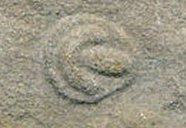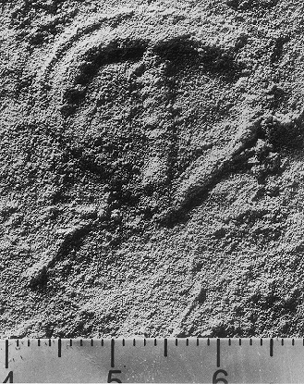Parvancorina is from the Ediacaran period and is one of the many problematic species from that time. It is shield shaped and has ridges which can be quite large in unflattened fossils. Some impressions suggest that it had 10 pairs of legs, perhaps optimistically seen as biramous by some.
Like many other Ediacaran forms, Parvancorina has been known to dominate entire beds and is found to have faced into oncoming currents. This behaviour may have implications on the possibility of it being an ancestral trilobite, as trilobite larvae in the "protaspid" stage are planktonic as can be seen in the image below.
 The support for Parvancorina being a potential ancestor to arthropods, particularly trilobites, comes from its resemblance to the protaspid stage of many trilobites. The protaspid stage is the earliest stage in development where the trilobite has a calcareous shell and is not segmented. For more on trilobite ontogeny see here. Primicaris was originally thought to be a larval naraoid trilobite before becoming its own taxon, which is a potential link between Parvancorina and the trilobites.
The support for Parvancorina being a potential ancestor to arthropods, particularly trilobites, comes from its resemblance to the protaspid stage of many trilobites. The protaspid stage is the earliest stage in development where the trilobite has a calcareous shell and is not segmented. For more on trilobite ontogeny see here. Primicaris was originally thought to be a larval naraoid trilobite before becoming its own taxon, which is a potential link between Parvancorina and the trilobites. If the link to the trilobites is true, then the central ridge and lobes may be analogous to the gut system of trilobites. The picture on the right shows the protaspid stage of a trilobite (a) though it should be noted that there are a wide range of protaspid morphologies amongst the trilobites. For examples, see here and here (image compares Parvancorina on the left, Primicaris in the centre, and a protaspis on the right).
The link to trilobites may never be fully established. Based on morphology alone the connection to the trilobite protaspid stage is quite convincing, however, behavioural evidence (facing the current) and the way they develop must not be ignored. Either way, this is a fascinating critter which does not get enough attention. Below is an image of Parvancorina with Vendia.







No comments:
Post a Comment